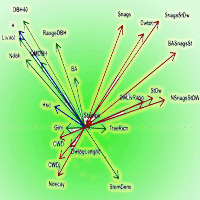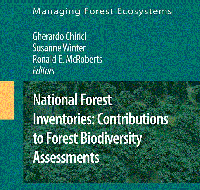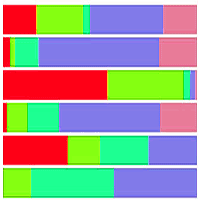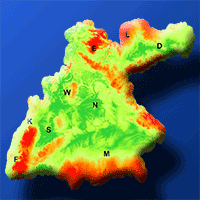A broad interest exists in developing structure-based indicators to use as proxies for other attributes that are difficult to assess, such as biological diversity. Summary variables that account for stand-scale forest structural complexity could facilitate the comparison among stands and provide a means of ranking stands in terms of their potential contribution to biodiversity. We developed an index of structural heterogeneity (SHI) for beech forests in southern Italy: (i) we established a preliminary list of 23 structural variables obtained from data routinely collected in forest inventories; (ii) we quantified these variables in a set of 64 beech-dominated stands encompassing a wide range of variability in the Cilento, Vallo di Diano and Alburni National Park; (iii) we identified a core set of attributes that take into account the main sources of structural heterogeneity identified in reference old-growth forests; and (iv) we combined these core attributes into a simple additive index (SHI). We identified eight core attributes that were rescaled to the range 0 to 10 using regression equations based on raw attribute data. The SHI was calculated as the sum of these attribute scores and then expressed as a percentage. The index performance was evaluated against ten reference old-growth beech stands in the Apennines. The index ranged between 38 and 79.1 (median=59.4) and was distributed normally for the calibration dataset. The SHI successfully discriminated between old-growth (range=71.9-99.9, median=85.1) and early-mature to mature forests. Furthermore, the SHI linearly increased with stand age and was higher in multi-layer high forests than in single- and double-layer forests. However, a large variation was detected within both management types and age classes. SHI could be helpful for foresters as a tool for quantifying and comparing structural heterogeneity before and after a silvicultural intervention aimed at restoring the structural complexity in second-growth stands.
Keywords
, , , ,
Citation
Sabatini FM, Burrascano S, Lombardi F, Chirici G, Blasi C (2015). An index of structural complexity for Apennine beech forests. iForest 8: 314-323. - doi: 10.3832/ifor1160-008
Academic Editor
Renzo Motta
Paper history
Received: Oct 22, 2013
Accepted: May 21, 2014
First online: Sep 03, 2014
Publication Date: Jun 01, 2015
Publication Time: 3.50 months
© SISEF - The Italian Society of Silviculture and Forest Ecology 2015
Open Access
This article is distributed under the terms of the Creative Commons Attribution-Non Commercial 4.0 International (https://creativecommons.org/licenses/by-nc/4.0/), which permits unrestricted use, distribution, and reproduction in any medium, provided you give appropriate credit to the original author(s) and the source, provide a link to the Creative Commons license, and indicate if changes were made.

Breakdown by View Type
(Waiting for server response...)
Article Usage
Total Article Views: 59194
(from publication date up to now)
Breakdown by View Type
HTML Page Views: 47006
Abstract Page Views: 3756
PDF Downloads: 7023
Citation/Reference Downloads: 46
XML Downloads: 1363
Web Metrics
Days since publication: 4123
Overall contacts: 59194
Avg. contacts per week: 100.50
Article Citations
Article citations are based on data periodically collected from the Clarivate Web of Science web site
(last update: Mar 2025)
Total number of cites (since 2015): 29
Average cites per year: 2.64
Publication Metrics
by Dimensions ©
Articles citing this article
List of the papers citing this article based on CrossRef Cited-by.
(1)
Barbier S, Gosselin F, Balandier P (2008)Influence of tree species on understory vegetation diversity and mechanisms involved - A critical review for temperate and boreal forests. Forest Ecology and Management 254: 1-15.
CrossRef |
Gscholar
(2)
Barbier S, Chevalier R, Loussot P, Bergès L, Gosselin F (2009)Improving biodiversity indicators of sustainable forest management: tree genus abundance rather than tree genus richness and dominance for understory vegetation in French lowland oak hornbeam forests. Forest Ecology and Management 258: S176-S186.
CrossRef |
Gscholar
(3)
Bartels SF, Chen HYH (2009)Is understory plant species diversity driven by resource quantity or resource heterogeneity? Ecology 91: 1931-1938.
CrossRef |
Gscholar
(4)
Bianchi L, Bottacci A, Calamini G, Maltoni A, Mariotti B, Quilghini G, Salbitano F, Tani A, Zoccola A, Paci M (2011)Structure and dynamics of a beech forest in a fully protected area in the northern Apennines (Sasso Fratino, Italy). iForest 4: 136-144.
CrossRef |
Gscholar
(5)
Blasi C, Marchetti M, Chiavetta U, Aleffi M, Audisio P, Azzella MM, Brunialti G, Capotorti G, Del Vico E, Lattanzi E, Persiani AM, Ravera S, Tilia A, Burrascano S (2010)Multi-taxon and forest structure sampling for identification of indicators and monitoring of old-growth forest. Plant Biosystems 144: 160-170.
CrossRef |
Gscholar
(6)
Brunialti G, Frati L, Aleffi M, Marignani M, Rosati L, Burrascano S, Ravera S (2010)Lichens and bryophytes as indicators of old-growth features in Mediterranean forests. Plant Biosystems 144: 221-233.
CrossRef |
Gscholar
(7)
Burrascano S, Lombardi F, Marchetti M (2008)Old-growth forest structure and deadwood: are they indicators of plant species composition? A case study from central Italy. Plant Biosystems 142: 313-323.
CrossRef |
Gscholar
(8)
Burrascano S, Sabatini FM, Blasi C (2011)Testing indicators of sustainable forest management on understorey composition and diversity in southern Italy through variation partitioning. Plant Ecology 212: 829-841.
CrossRef |
Gscholar
(9)
Burrascano S, Keeton WS, Sabatini FM, Blasi C (2013)Commonality and variability in the structural attributes of moist temperate old-growth forests: a global review. Forest Ecology and Management 291: 458-479.
CrossRef |
Gscholar
(10)
Calamini G, Maltoni A, Travaglini D, Iovino F, Nicolaci A, Menguzzato G, Corona P, Ferrari B, Di Santo D, Chirici G, Lombardi F (2011)Stand structure attributes in potential old-growth forests in the Apennines, Italy. L’Italia Forestale e Montana 66: 365-381.
CrossRef |
Gscholar
(11)
Castagneri D, Garbarino M, Berretti R, Motta R (2010)Site and stand effects on coarse woody debris in montane mixed forests of Eastern Italian Alps. Forest Ecology and Management 260: 1592-1598.
CrossRef |
Gscholar
(12)
Chiavetta U, Sallustio L, Garfì V, Maesano M, Marchetti M (2012)Classification of the oldgrowthness of forest inventory plots with dissimilarity metrics in Italian National Parks. European Journal of Forest Research 131: 1473-1483.
CrossRef |
Gscholar
(13)
Chirici G, Winter S, McRoberts RE (2011)National forest inventories: contributions to forest biodiversity assessments. Springer, Berlin and Heidelberg, Germany, pp. 206.
CrossRef |
Gscholar
(14)
Chirici G, McRoberts RE, Winter S, Bertini R, Brändli U-B, Asensio IA, Bastrup-Birk A, Rondeux J, Barsoum N, Marchetti M (2012)National forest inventory contributions to forest biodiversity monitoring. Forest Science 58: 257-268.
CrossRef |
Gscholar
(15)
Corona P, Chirici G, McRoberts RE, Winter S, Barbati A (2011)Contribution of large-scale forest inventories to biodiversity assessment and monitoring. Forest Ecology and Management 262: 2061-2069.
CrossRef |
Gscholar
(16)
Donato DC, Campbell JL, Franklin JF (2012)Multiple successional pathways and precocity in forest development: can some forests be born complex? Journal of Vegetation Science 23: 576-584.
CrossRef |
Gscholar
(17)
Franklin JF, Spies TA, Van Pelt R, Carey AB, Thornburgh DA, Berg DR, Lindenmayer DB, Harmon ME, Keeton WS, Shaw DC, Bible K, Chen JQ (2002)Disturbances and structural development of natural forest ecosystems with silvicultural implications, using Douglas-fir forests as an example. Forest Ecology and Management 155: 399-423.
CrossRef |
Gscholar
(18)
Gasparini P, Tabacchi G (2011)L’Inventario Nazionale delle Foreste e dei serbatoi forestali di Carbonio INFC 2005 [The national inventory of forests and carbon stocks INFC 2005.]. Secondo inventario forestale nazionale italiano. Metodi e risultati. Ministero delle Politiche Agricole, Alimentari e Forestali, Corpo Forestale dello Stato, Consiglio per la Ricerca e la Sperimentazione in Agricoltura, Unità di ricerca per il Monitoraggio e la Pianificazione Forestale, Edagricole-Il Sole 24 ore, Bologna, pp. 653.
Gscholar
(19)
Gualdi V, Tartarino P (2006)Altre riflessioni sulla gestione su basi assestamentali della foresta mediterranea europea [Further notes on the management and harvest planning of European Mediterranean forests]. Italia Forestale e Montana 61: 477-487. [in Italian with English abstract]
CrossRef |
Gscholar
(20)
Hao ZQ, Zhang J, Song B, Ye J, Li BH (2007)Vertical structure and spatial associations of dominant tree species in an old-growth temperate forest. Forest Ecology and Management 252: 1-11.
CrossRef |
Gscholar
(21)
Hatanaka N, Wright W, Loyn RH, MacNally R (2011)“Ecologically complex carbon” - linking biodiversity values, carbon storage and habitat structure in some austral temperate forests. Global Ecology and Biogeography 20: 260-271.
CrossRef |
Gscholar
(22)
Hoover CM, Leak WB, Keel BG (2012)Benchmark carbon stocks from old-growth forests in northern New England, USA. Forest Ecology and Management 266: 108-114.
CrossRef |
Gscholar
(23)
Houghton RA (2005)Aboveground forest biomass and the global carbon balance. Global Change Biology 11: 945-958.
CrossRef |
Gscholar
(24)
Hunter ML (1990)Wildlife, forests and forestry: principles of managing forests for biological diversity. Prentice Hall, Englewood Cliffs, NJ, USA, pp. 270.
Gscholar
(25)
Jung K, Kaiser S, Bohm S, Nieschulze J, Kalko EKV (2012)Moving in three dimensions: effects of structural complexity on occurrence and activity of insectivorous bats in managed forest stands. Journal of Applied Ecology 49: 523-531.
CrossRef |
Gscholar
(26)
Keeton WS (2006)Managing for late-successional/old-growth characteristics in northern hardwood-conifer forests. Forest Ecology and Management 235: 129-142.
CrossRef |
Gscholar
(27)
Lassauce A, Paillet Y, Jactel H, Bouget C (2011)Deadwood as a surrogate for forest biodiversity: Meta-analysis of correlations between deadwood volume and species richness of saproxylic organisms. Ecological Indicators 11: 1027-1039.
CrossRef |
Gscholar
(28)
Lindenmayer DB, Margules CR, Botkin DB (2000)Indicators of biodiversity for ecologically sustainable forest management. Conservation Biology 14: 941-950.
CrossRef |
Gscholar
(29)
Lombardi F, Cocozza C, Lasserre B, Tognetti R, Marchetti M (2011)Dendrochronological assessment of the time since death of dead wood in an old growth Magellan’s beech forest, Navarino Island (Chile). Austral Ecology 36: 329-340.
CrossRef |
Gscholar
(30)
Lombardi F, Lasserre B, Chirici G, Tognetti R, Marchetti M (2012)Deadwood occurrence and forest structure as indicators of old-growth forest conditions in Mediterranean mountainous ecosystems. Ecoscience 19: 344-355.
CrossRef |
Gscholar
(31)
Lombardi F, Chirici G, Marchetti M, Tognetti R, Lasserre B, Corona P, Barbati A, Ferrari B, Di Paolo S, Giuliarelli D, Mason F, Iovino F, Nicolaci A, Bianchi L, Maltoni A, Travaglini D (2010)Deadwood in forest stands close to old-growthness under Mediterranean conditions in the Italian Peninsula. Italia Forestale e Montana 65: 481-504.
CrossRef |
Gscholar
(32)
McElhinny C, Gibbons P, Brack C (2006)An objective and quantitative methodology for constructing an index of stand structural complexity. Forest Ecology and Management 235: 54-71.
CrossRef |
Gscholar
(33)
McElhinny C, Gibbons P, Brack C, Bauhus J (2005)Forest and woodland stand structural complexity: Its definition and measurement. Forest Ecology and Management 218: 1-24.
CrossRef |
Gscholar
(34)
McRoberts RE, Winter S, Chirici G, Lapoint E (2012)Assessing Forest Naturalness. Forest Science 58 (3): 294-309.
CrossRef |
Gscholar
(35)
Motta R, Berretti R, Castagneri D, Dukic V, Garbarino M, Govedar Z, Lingua E, Maunaga Z, Meloni F (2011)Toward a definition of the range of variability of central European mixed Fagus-Abies-Picea forests: the nearly steady-state forest of Lom (Bosnia and Herzegovina). Canadian Journal of Forest Research 41: 1871-1884.
CrossRef |
Gscholar
(36)
Neumann M, Starlinger F (2001)The significance of different indices for stand structure and diversity in forests. Forest Ecology and Management 145: 91-106.
CrossRef |
Gscholar
(37)
Nilsson SG, Niklasson M, Hedin J, Aronsson G, Gutowski JM, Linder P, Ljungberg H, Mikusinski G, Ranius T (2002)Densities of large living and dead trees in old-growth temperate and boreal forests. Forest Ecology and Management 161: 189-204.
CrossRef |
Gscholar
(38)
Norris C, Hobson P, Ibisch PL (2012)Microclimate and vegetation function as indicators of forest thermodynamic efficiency. Journal of Applied Ecology 49 (3): 562-570.
CrossRef |
Gscholar
(39)
Persiani AM, Audisio P, Lunghini D, Maggi O, Granito VM, Biscaccianti AB, Chiavetta U, Marchetti M (2010)Linking taxonomical and functional biodiversity of saproxylic fungi and beetles in broad-leaved forests in southern Italy with varying management histories. Plant Biosystems 144: 250-261.
CrossRef |
Gscholar
(40)
Piovesan G, Di Filippo A, Alessandrini A, Biondi F, Schirone B (2005)Structure, dynamics and dendroecology of an old-growth
Fagus forest in the Apennines. Journal of Vegetation Science 16 (1): 13-28.
CrossRef |
Gscholar
(41)
R Development Core Team (2011)R: a language and environment for statistical computing. R Foundation for Statistical Computing, Vienna, Austria.
Online |
Gscholar
(42)
Rugani T, Diaci J, Hladnik D (2013)Gap dynamics and structure of two old-growth beech forest remnants in Slovenia. PLoS ONE 8: e52641.
CrossRef |
Gscholar
(43)
Sabatini FM, Burrascano S, Blasi C (2010)Niche heterogeneity and old-growth conservation value. Italia Forestale e Montana 65: 621-636.
CrossRef |
Gscholar
(44)
Sabatini FM, Burrascano S, Tuomisto H, Blasi C (2014)Ground layer plant species turnover and beta diversity in southern-european old-growth forests. PLoS One 9 (4): e95244.
CrossRef |
Gscholar
(45)
Schall P, Ammer C (2013)How to quantify forest management intensity in Central European forests. European Journal of Forest Research 132: 379-396.
CrossRef |
Gscholar
(46)
Ståhl G, Cienciala E, Chirici G, Lanz A, Vidal C, Winter S, McRoberts RE, Rondeux J, Schadauer K, Tomppo E (2012)Bridging national and reference definitions for harmonizing forest statistics. Forest Science 58: 214-223.
CrossRef |
Gscholar
(47)
Staudhammer CL, LeMay VM (2001)Introduction and evaluation of possible indices of stand structural diversity. Canadian Journal of Forest Research 31: 1105-1115.
CrossRef |
Gscholar
(48)
Taboada A, Tarrega R, Calvo L, Marcos E, Marcos JA, Salgado JM (2010)Plant and carabid beetle species diversity in relation to forest type and structural heterogeneity. European Journal of Forest Research 129: 31-45.
CrossRef |
Gscholar
(49)
Travaglini D, Paffetti D, Bianchi L, Bottacci A, Bottalico F, Giovannini G, Maltoni A, Nocentini S, Vettori C, Calamini G (2012)Characterization, structure and genetic dating of an old-growth beech-fir forest in the northern Apennines (Italy). Plant Biosystems 146: 175-188.
CrossRef |
Gscholar
(50)
Whitman AA, Hagan JM (2007)An index to identify late-successional forest in temperate and boreal zones. Forest Ecology and Management 246: 144-154.
CrossRef |
Gscholar
(51)
Winter S, Moller GC (2008)Microhabitats in lowland beech forests as monitoring tool for nature conservation. Forest Ecology and Management 255: 1251-1261.
CrossRef |
Gscholar
(52)
Zenner EK, Hibbs DE (2000)A new method for modeling the heterogeneity of forest structure. Forest Ecology and Management 129: 75-87.
CrossRef |
Gscholar
(53)
Zotti M, Persiani AM, Ambrosio E, Vizzini A, Venturella G, Donnini D, Angelini P, Di Piazza S, Pavarino M, Lunghini D, Venanzoni R, Polemis E, Granito VM, Maggi O, Gargano ML, Zervakis GI. (2013)Macrofungi as ecosystem resources: conservation versus exploitation. Plant Biosystems 147: 219-225.
CrossRef |
Gscholar


















